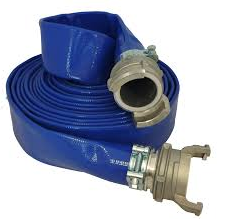MODULE HOSES 250 m + couplings 2"
Valid Article
MODULE HOSES 250 m + couplings 2"
Definition
2" hoses for motor pump and water tank kits, used to transport water over prolonged lengths during emergencies and short-term programs.
Can also be used in combination with the modules "water distribution" and "additional hoses" (see related articles below) to set up an extensive distribution network (by gravity or by means of a motor pump).
Indications
The module contains 250 meters of food grade quality, 2" ND50, flat hose with set Guillemin couplings.
Specifications
Components
- 5 rings 50 m of 2 " flattenable hose
- 10 Guillemins fittings 2"
- 10 BAND CLIP high pressure
Instructions for use
Particularly useful when pumping, storage, treatment and distribution are performed at considerable distances from each other.
Before ordering, make a drawing of the water distribution system and estimate the length of hose required.
Flat hoses are sensitive to punctures, shocks and sunlight. They can be laid in narrow shallow protective trenches. Anchoring of the system at bends can also be done by using reinforcing bars and concrete.
For long term use, PE or even PVC pipes are a better choice as they can be buried and protected more easily.
To produce an adequate flow at the discharge point, the best option is to use a high pressure pump (KWATKPUD18H); but it is also possible to run two pumps in series.
Should two pumps be connected in series then it is important that the following starting and stopping regime is followed to prevent water hammering: P1 => P2 => GV
(=>: flow direction, P1: pump 1, P2: pump 2, GV: gate valve)
Starting regime:
The gate valve is nearly completely closed
- P1 start and idle
- P2 start and idle
- P1 rev up
- P2 rev up
- Open the gate valve (slowly)
Stopping regime:
Close the gate valve (not completely) until hissing sound is heard
- P2 rev down
- P1 rev down
- P2 stop
- P1 stop
For more detailed information and instructions see also "Public Health Engineering in Precarious Situations", MSF, 2nd edition, 2010:
- T.B. 2.30 Pipes for potable water supply
- T.B. 2.31 Head losses
- T.B. 2.32 Calculation of a simple pipeline
- T.B. 2.33 Pipe installation,

